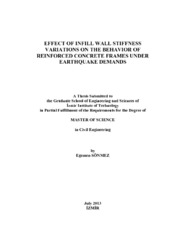Please use this identifier to cite or link to this item:
https://hdl.handle.net/11147/3567| Title: | Effect of infill wall stiffness variations on the behavior of reinforced concrete frames under earthquake demands | Authors: | Sönmez, Egemen | Advisors: | Dönmez, Cemalettin | Publisher: | Izmir Institute of Technology | Abstract: | Reinforced concrete (RC) structures with infill walls are the most common building types in earthquake-prone regions of Turkey. Due to the complications in modeling the infill wall - frame interaction, they are generally neglected in structural design. However, presence of the infill walls has been proved to affect stiffness, strength and behavior of the structures significantly. Effects of infill walls may be either beneficial or detrimental under seismic demands. Infill walls typically increase the stiffness and strength of the structures. This situation may be advantageous for nonductile buildings up to a certain limit. However, brittle nature and variety of failure modes of infill walls may cause unforeseen and irreversible damages. Particularly, softstory mechanisms may occur due to drift concentrations at lower stories. An organized stiffness distribution along the height of the structure may help mitigating these negative effects. The main purpose of the study is to investigate the effects of stiffness variations in infill walls to the behavior of the frames. In order to achieve the purpose, an analytical software that supports an infill model, was selected. The software is calibrated and verified by simulating a series of experiments. Afterwards, a planar, fivestory, five-bay reinforced concrete frame was designed with common deficiencies observed in residential buildings in Turkey. The performance of the bare frame (BF) was determined using pushover analysis. Then, two types of infilled frames were obtained by introducing infill walls into two bays. The infill walls of the first infilled frame (IF-1) had a uniform stiffness and strength distribution along the height of the frame. In the second infilled frame (IF-2), the stiffness and strength of the infill walls had a decreasing profile from the bottom to the top story. By this distribution, drift concentration at the lower stories was aimed to be mitigated. Nonlinear dynamic and pushover analyses were performed on the frames. The results indicated that the organized stiffness distribution of IF-2 mitigated the drift concentrations and improved he seismic performance of the frame. | Description: | Thesis (Master)--Izmir Institute of Technology, Civil Engineering, Izmir, 2013 Includes bibliographical references (leaves: 79-81) Text in English; Abstract: Turkish and English xi, 83 leaves |
URI: | http://hdl.handle.net/11147/3567 |
| Appears in Collections: | Master Degree / Yüksek Lisans Tezleri |
Files in This Item:
| File | Description | Size | Format | |
|---|---|---|---|---|
| T001099.pdf | MasterThesis | 3.54 MB | Adobe PDF |  View/Open |
CORE Recommender
Page view(s)
164
checked on Jul 15, 2024
Download(s)
96
checked on Jul 15, 2024
Google ScholarTM
Check
Items in GCRIS Repository are protected by copyright, with all rights reserved, unless otherwise indicated.